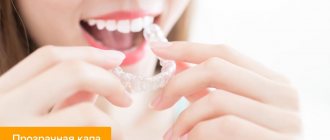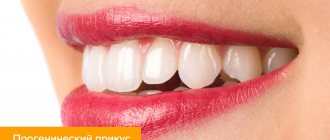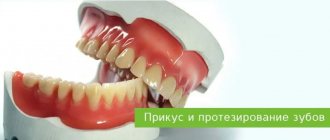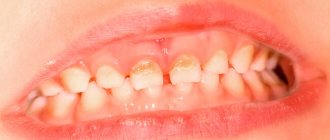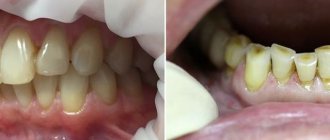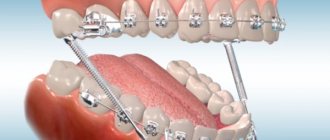For the sake of a child’s beautiful smile, parents are willing to spend time visiting specialists - dentists and orthodontists, selecting and testing advanced methods for treating incorrect bites and diction disorders caused by improper development of the jaw muscles.
But in fact, you can achieve excellent results by using the T4k orthodontic trainer, which is considered an effective and economical means of eliminating malocclusion and disorders in the development of the speech apparatus in children aged 5 to 12 years.
What it looks like, what its characteristics and advantages are compared to other means that help straighten teeth and develop maxillofacial muscles - read below.
What are dental trainers?
Dental trainers are a double-jaw orthodontic device that tightly secures the upper and lower dentition, gradually correcting the incorrect position of the teeth, training the facial muscles and fixing the tongue in the correct position. The design has several components:
- outer part with lip bumpers;
- labial protrusion in the form of an arc;
- part in the oral cavity (tongue stop);
- “tongue”, which is located on the front part from the inside.
Bottom line
Problems with bite and other dental defects affect every second person in the modern world. Natural deficiencies in the anatomical structure of the jaw, injuries and bad habits can be corrected with the help of orthodontics. Plates and braces have been replaced by special dental trainers - orthodontic trainers, which effectively correct underdeveloped facial skeletons and other jaw pathologies. The affordable price, trouble-free operation of the trainers and easy care allow every adult and child to solve problems with dental pathologies.
The absence of metal parts and the elasticity of the material are a huge advantage of trainers over other orthodontic systems. The principle of operation of the simulators is not aimed at eliminating symptoms, but at eliminating the causes of pathological development of the jaw. This is an innovative development that prevents relapses during dental correction. Now you can correct not only your smile line, but also get rid of bad habits, overcome snoring and correct abnormal mouth breathing.
Sources used:
- Manufacturer's official website
- Vanarsdall,RL and White,RPJr. — Replais & Retencion: Professional and public attitudes, Am.J.Orthod. 98:184, 1990
- — Principles of retention in orthodontia
What are dental trainers for?
A trainer for straightening teeth is usually prescribed to children aged 5 - 12 years, during the period of mixed dentition. Timely use of the device will eliminate serious problems in the future, since in adulthood, when the jaw bones are already formed, the bite can only be radically corrected through surgery. However, doctors warn that correcting teeth with trainers will only be useful if you follow the wearing regime. If a small patient is not motivated enough or his parents cannot control the process, the technique will not bring results.
A dental trainer for children is prescribed for the following indications:
- mouth breathing;
- parafunction of the tongue;
- bad sucking habits;
- improper eruption of front teeth;
- narrowing of the dentition;
- various malocclusions;
- pronounced crowding of teeth (the teeth do not have enough space on the gums, and they move each other).
Dental trainers are also used to treat patients over 12 years of age who already have a permanent bite. They are used for the following diagnoses:
- class II anomalies (subclasses 1 and 2, distal displacement of the lower first molar in relation to the upper one);
- crowding of the front teeth;
- deep or open bite.
An important purpose of trainers is to form the correct functioning of the jaw muscles, which is very difficult to achieve with the help of plates or braces. A separate function of silicone teeth trainers is retention after wearing braces. However, in most cases, trainers are prescribed to children.
Advantages
By choosing the T4k orthodontic trainer, you will ensure:
- high margin of safety: the device is made of silicone, which does not deform under strong pressure, does not shrink or crack. This means that the child will wear the mouthguard for a long period of time and will not damage it during cleaning;
- hypoallergenic: silicone is a safe material. It does not release toxins, compounds and chemical components that have a negative effect on the body of a small patient. This property of the material has been proven in clinical studies;
- practicality: to keep the trainer in perfect condition, it is enough to wash it in a timely manner under running warm water;
- convenience: a correctly selected mouthguard does not cause any discomfort, anxiety or irritation;
- multifunctionality: the t4k trainer eliminates several defects associated with the location of the dentition and bite;
- short period of use: unlike braces, which need to be worn for at least a year, trainers eliminate deviations in the development of the bite or dentition in a shorter period of time;
- bright design: colorful things attract the child and evoke positive emotions. This trainer is no exception. It is made in blue or pink, i.e. in shades that modern children like.
And the main thing is that their use does not interfere with the active life of the child: you can wear the T4k orthodontic trainer at home, when relatives or friends are nearby. This is an important point, since the child will not be embarrassed and refuse to communicate with peers just because he is undergoing treatment, or worry about offensive nicknames received due to wearing braces.
Trainers for teeth - children and adults
In pediatric and adult orthodontics, various models of trainers are used to straighten teeth, each of which has its own purpose.
Trainers for teeth T4K
For older children, T4K dental trainers, the so-called pre-orthodontic ones, are suitable. Treatment on such trainers takes place in two stages - first, the patient wears a soft initial device (blue), then, upon achieving the goals, it is replaced with a more elastic one (pink or red). T4K dental trainers are suitable for early and late mixed dentition. There are also models of trainers for teeth i-3 and i-2 and their varieties, specially designed for the treatment of class 2 and 3 anomalies.
Teeth Trainer T4A
T4A dental trainers are available as initial and final trainers. Initial (blue) is used on replacement teeth. It has a special recess so that the child understands where to put his tongue. This species is almost imperceptible in the mouth. The period of its use varies from 6 to 8 months. The final pink T4A dental trainer provides a more rigid hold on the dentition. You need to wear it for another 6 to 12 months.
Teeth trainer i-3
The i-3 teeth trainer is used to prevent bite defects during the early change of baby teeth. Its wearing period ranges from 4 to 8 months.
Teeth trainers T4A for adults
Orthodontic trainers for teeth T4A are in many ways similar to T4K for children, they are distinguished by slightly increased height of the sides of the labial arches and longer distal ends. Such devices are also available in two types of hardness - initial and final. Such trainers help in the cosmetic alignment of the front teeth and in minor relapses after orthodontic treatment.
Corrective therapy algorithm
The therapy process is conventionally divided into 2 stages:
- 1 half of the course lasts about six months (the period may vary depending on the severity of the pathology). During this time, the patient uses trainers made of soft polymer. This allows the child to get used to the treatment process and adapt to the physical pressure on the teeth;
- Stage 2 involves wearing more rigid structures. With their help, the correction process is completed and the result is consolidated. Duration – from 1 to 1.5 years, in more complex cases, at the discretion of the doctor.
Note: if the doctor determines a mild form of the dental defect, then the course may be shorter. In this case, devices made of hard polymer are immediately used.
How long and how to wear a dental trainer?
The duration of treatment with trainers will depend on the diagnosis. The minimum is 11 - 12 months. In some cases, after wearing trainers, further orthodontic treatment with braces or Invisalign aligners may be required. However, the period of additional treatment will be shorter than without first wearing dental trainers. How to wear a dental trainer? During treatment, the patient wears the device for at least an hour a day and wears it at night.
How to put on a dental trainer? To install the device, you need to place it with the “marker tongue” up and place it so that the tongue touches this “tongue”, then lightly press it with your teeth. Keep in mind that with the trainer installed in your mouth, you can only breathe through your nose. Before putting on an orthodontic trainer, you must thoroughly brush your teeth and wash the device itself with a cleaning agent.
Functional devices for correcting malocclusion in children
Their meaning lies in the fact that they do not have a source of mechanical force (like, say, braces or plates), and here the main effect is achieved through the action of the child’s muscles.
What are the advantages of functional devices? Three advantages:
- First plus
. Again, due to the fact that they eat without them, they do not disrupt food intake and do not impose any restrictions. - Second plus
. Again, they do not make oral hygiene difficult; the child can do this absolutely calmly. - Third plus
. Well, they are quite effective. But the effectiveness here is questionable, because everything depends on the mode in which the child wears this device. If he wears it, the effect develops quite quickly; if not, then it is clear that there is no effect either.
What are the disadvantages of functional devices? There are two disadvantages, but they are significant:
- The first disadvantage
is that most functional devices are very bulky. They consist of a metal frame of a very sophisticated design and plastic parts. Therefore, they also take up a lot of space in the mouth and are quite inconvenient. - Well, the second disadvantage
is that, unlike, say, an elastopositioner, they need to be worn for the maximum number of hours per day. That is, the child must wear them both at school and at home, which, of course, also does not bring much pleasure and often provokes a refusal of these devices.
The fourth way
to correct dental occlusion in children is braces, oddly enough.
Trainer care rules
- The orthodontic trainer should be washed with running water after each meal, but it is contraindicated to use boiling water or ice water.
- The device must be cleaned at least twice a day with a brush and paste.
- The orthodontic dental trainer should be stored in a special container.
- The teeth straightening trainer should not be dropped, chewed or moved in the mouth while talking.
If cracks or damage appear on the device, it is necessary to immediately inform the attending orthodontist, since the structure may lose its properties, and bacteria may accumulate in the cracks.
For whom is it intended?
T4K trainers are designed for a specific group of patients. These are children from 5 to 12 years old.
Such designs are prescribed if :
- the child was diagnosed with a connection of teeth in one place where the lower jaw incisors grow;
- with deep bite;
- if the child has an open bite in the central area;
- Engel class I, II and mildly manifested III;
- incorrect position of the lower jaw;
- bad habits of the child (difficulty breathing, sucking foreign objects, improper swallowing), as well as difficulties in pronouncing words and letters;
- The lower jaw is positioned incorrectly and unnaturally.
User manual
Trainers should be used strictly following the instructions issued by the doctor. If children are unable to place mouth guards on their own, adults can help them. The installation process of the structure consists of several stages, you must:
- place the trainer in your mouth with the tongue facing up;
- feel the tip of the tongue of the product with your tongue;
- squeeze the trainers with your teeth until you feel pressure on the crowns;
- Close your lips tightly and try to breathe through your nose.
Do not talk, eat, drink or laugh while wearing dental trainers.
Reviews
The majority of patients and their parents are satisfied with the results of treatment using the T4K pre-orthodontic trainer. Everyone notes its convenience and ease of use, as well as greater efficiency.
You can share your experience of using both types of this device by leaving a comment below.
If you find an error, please select a piece of text and press Ctrl+Enter.
Tags: bite correction, bite trainers for children
Did you like the article? stay tuned
Previous article
Dental varnish: how does it work, who is it suitable for?
Next article
Deep bite: general information


